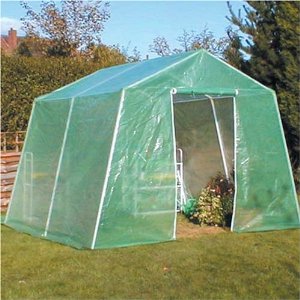Most people begin replanting their vegetable gardens in April and May, but with a small temporary greenhouse, gardening can begin in February and March. As soon as the weather breaks in late January or February, a small temporary greenhouse can be constructed over the area where you plan to garden.

For easier soil preparation, the greenhouse can be installed over a location where you have previously gardened or where soil has already been prepared for the new season. Never locate a plastic-covered greenhouse in a natural wind tunnel, where high winds could remove or destroy the greenhouse film.
The plastic needs to be tough enough to withstand strong gusts of wind. If you plan to use the plastic more than a few months, it will need to withstand deterioration from ultraviolet light. Traditionally greenhouses are covered with a 6 mil film.
Temporary greenhouse frames can be built of common dimensional wood from the lumberyard or pieces left over from other construction projects. Frames also can be built from pipe, held together with brackets or other simple hardware. Small greenhouse structures can be designed as simple “A” frames that can be stacked during storage. Larger frames can be designed so that they can be assembled and disassembled easily, using nuts and bolts in predrilled holes.
Anyone who has basic carpentry skills or experience with framing barns and sheds can help you design and build a simple temporary greenhouse. It needs to be strong enough to withstand spring winds and should be secured to the ground at each corner and at every six-foot span.
Once the structure has been covered with a plastic film, the sun will begin to warm the ground. Covering the ground, with a dark ground cover, will increase the rate at which the ground will absorb heat. Close the greenhouse completely to trap additional heat from the sun and increase the rise in soil temperature.
Protected from the rain, the soil will begin to dry. When it becomes too dry, add water as needed. After a few sunny days, the ground will be ready to prepare for planting.
Seeds for cool weather crops, including peas, turnips, radishes, beets, carrots, onions, lettuce, spinach, and Swiss chard, can be planted in the ground two to three months earlier in a temporary greenhouse structure. Check the ground temperature before planting. If you need assistance, follow these guidelines from Oregon State University for the optimum soil temperature ranges for germinating seed varieties.
Some cold weather plants will germinate and grow more quickly in a warmer space than a temporary greenhouse will provide. Greens, broccoli, cabbage, onions, and other cool weather plants can be started indoors in flats or pots, on a small, lighted shelf. They can be transplanted into the temporary greenhouse in February or March as three-to-six-week-old plants and be ready to harvest sooner. When covered at night, with an additional insulating blanket inside the greenhouse, most plants will require no additional heat.
Tomato, pepper, cucumber, and other warm weather plants also can be grown inside under lights and transplanted into a temporary greenhouse in March or April, one to two months before the normal date for transplanting in your area. On nights when outside temperatures drop below freezing, additional heat will be required to prevent warm weather plants from freezing. This can be done inexpensively by covering them with an additional layer of plastic or an insulating blanket and turning on a small space heater under the blanket/plastic.
As summer approaches and days become hot, the plastic can be removed during the day to prevent cool weather crops from becoming bitter or bolting and going to seed too early. The greenhouse film or insulating blanket, or both, can be replaced nightly or during cold periods when night temperatures drop below 40ºF.
Removing the cover during warm days will allow insects to improve pollination, which is required for some plants to set fruit. Natural controls, for unwanted insects, will arrive earlier. Rain will replenish soil moisture, minimizing the need to water plants.
Temporary growing structures can be simple or elaborate, but following the last expected frost, they are usually removed to facilitate gardening through the summer. In the fall, temporary structures can be replaced to extend garden production into the fall and winter.
Gini Coover is the author of The Natural Greenhouse, Growing Plants and Food for Profit. She has grown greenhouse plants and vegetables for twenty-eight years.
Related Articles & Free Email Newsletter
Building a Seasonal Greenhouse
Greenhouse Gardening for Beginners



Comment here